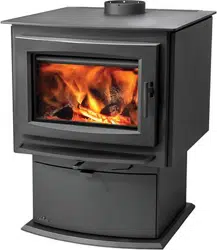Loading ...
Loading ...
Loading ...

W415-1476 / A / 09.30.16
23
EN
Your appliance is Hi-Tech, designed with the most advanced technology. This appliance is extremely airtight.
It has an exclusive direct outside air supply (optional kit), a feature designed to prevent spillage, and to
help keep your house free of carbon monoxide, in case of a down drafting chimney or an internal negative
pressure.
The fi rst fi re(s) in your appliance will be diffi cult to get going and keep going with little amount of heat being
generated. This is a result of the moisture being driven out of the fi re brick. During the break-in period (the
fi rst 2 or 3 fi res) create only small, fi res using kindling; this will allow the fi rebrick to cure. Do not be alarmed if
small hairline cracks develop in the fi rebrick. This is a normal occurrence and does not pose a safety hazard.
The paint may also smell a little for the fi rst few fi res as it cures and you may wish to open a door or window
to alleviate the smell.
To start, a brisk fi re is required. Place loosely crumpled paper on the fl oor of the appliance and cover with dry
kindling. Open the air control fully by pulling the lever forward. Light the paper and leave the door slightly ajar
(one inch/25.4mm) until all kindling is burning. To maintain a brisk fi re, a hot coal bed must be established and
maintained.
Slowly add larger wood (2” x 4” size pieces). Lay the pieces lengthwise from side to side in the hot coal
bed with a shallow trench between, so that the primary air can fl ow directly into this trench and ignite the
fuel above. When the fi re seems to be at its peak, medium sized logs may be added. Once these logs have
caught fi re, carefully close the door. (Closing the door too quickly after refuelling will reduce the fi rebox
temperature and result in an unsatisfactory burn.) Remember it is more effi cient to burn medium sized wood,
briskly, and refuel frequently than to load the appliance with large logs that result in a smouldering, ineffi cient
fi re and dirty glass.
As soon as the door is closed, you will observe a change in the fl ame pattern. The fl ames will get smaller and
lazier because less oxygen is getting into the combustion chamber. The fl ames, however, are more effi cient.
The fl ames will remain lazy but become larger again as soon as the fi rebricks have been heated thoroughly
and the chimney becomes heated and provides a good draft. At this point, the roaring fi re that you see when
the door is opened is wastefully drawing heated room air up the chimney -- certainly not desirable. Always
operate with the door fully closed once the medium sized logs have caught fi re.
You can now add larger pieces of wood and operate the appliance normally. Once the appliance is entirely
hot, it will burn very effi ciently with little smoke from the chimney. There will be a bed of orange coals in the
fi rebox and secondary fl ames fl ickering just below the top fi rebrick. You can safely fi ll the fi rebox with wood
to the top of the door and will get best burns if you keep the chimney connector temperatures between 250°F
(120°C) and 450°F (270°C).
Without an appliance thermometer, you are working blindly and have no idea of how the appliance is
operating! An appliance thermometer offers a guide to performance and should be located 18” (457mm)
above the fl ue collar into the chimney connector. Install the thermometer according to manufacturers
instructions.
Can’t get the fi re going?
Use more kindling and paper. Assuming the chimney and vent are sized correctly and there is suffi cient
combustion air, the lack of suffi ciently dry quantities of small kindling is the problem. Thumb size is a good
gauge for small kindling diameter.
Can’t get heat out of the appliance?
One of two things may have happened. The appliance door may have been closed prematurely and the
appliance itself has not reached optimum temperature. Reopen the door and/or draft control to re-establish
a brisk fi re. The other problem may have been wet wood. The typical symptom is sizzling wood and moisture
being driven from the wood.
Loading ...
Loading ...
Loading ...
